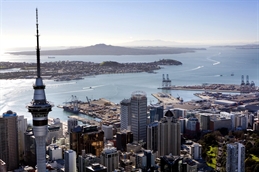
In spite of the current state of the sea-freight industry, ports in Australia and New Zealand are forging ahead with large expansion projects in preparation for an eventual improvement to containerized shipping across the world.
One of the main priorities for Ports of Auckland this year is the continued extension of its Fergusson container terminal, and in particular, the construction of a new berth which will be capable of handling 300-metre vessels.
“Work is going well,” says Matt Ball, a spokesperson for Ports of Auckland. “Late 2015, we finished a 50-metre extension of our main wharf and started work on a new berth across the north face of the terminal. This work is proceeding well and is due to be completed in 2017. In early 2016, we will be carrying out maintenance dredging of our channel and some berths. The dredged material will be used in the Fergusson reclamation.”
Ball says that the company is also focused on expanding its network of freight hubs across the North Island of New Zealand. In February 2016, the company signed a conditional agreement to acquire 33 hectares of land for development as a freight hub at Northgate Business Park in Waikato, about 8km north of Hamilton on the North Island.
“Establishing a freight hub in the Waikato is a central part of our supply chain strategy as it is one of New Zealand’s fastest-growing areas and a major freight generator,” says Tony Gibson, chief executive of Ports of Auckland. “Waikato will complete our North Island freight-hub network, complementing our existing sites in the Manawatu, Bay of Plenty and Wiri, South Auckland.”
According to the company, the deal is expected to be complete by March 31, 2016.
The Port of Melbourne, which handles approximately 2.6 million TEUs annually and is Australia’s largest container port, is in the process of reconfiguring its Webb Dock into an international container-handling facility. The contract for the design, construction, operation and maintenance of the new terminal was awarded to Victoria International Container Terminal, a wholly owned subsidiary of International Container Terminal Services, Inc.
The development at Webb Dock East is progressing well, within budget and is on schedule to begin hosting container-vessel arrivals from late 2016 or early 2017, according to the port.
“As you would expect of a project of this scope, it was a strong focus of Port of Melbourne Corporation’s total capital expenditure of A$311.1 million (US$221 million) in 2014-15,” says Peter Harry, head of corporate affairs at Port of Melbourne Corporation. “The diverse range of physical works has included over 3,000 piles being driven, minor dredging, installation of navigation aids at the northern end of Webb Dock and the construction of internal roads including a direct link from the port to the West Gate/M1 corridor, together with upgrades to the existing Todd Road roundabouts.”

On the other side of the country, the port of Fremantle has already completed a 290-metre extension to a rail terminal at its Inner Harbour facility, as well as the development of the Rous Head Industrial Area.
“One of the significant infrastructure projects in recent years at Fremantle Port has been the A$27.2 million (US$19.5 million) completion of roads and services on land reclaimed at Rous Head through the 2010 Inner Harbour deepening,” says Chris Leatt-Hayter, chief executive officer of Fremantle Ports. “The 27 hectares are being used for port purposes, mainly to increase efficiency in container-trade handling. The completion of roads and services for the Rous Head Industrial Park has improved efficiency and safety of road access to the container terminals and other key facilities. It has also reduced the risk of truck congestion at peak times.”
According to the port, the new land enabled the relocation of businesses, consolidation of leases and improved interface between related operations servicing the container trade.
“A truck-marshalling area, with adjacent fuelling facilities and amenities is improving traffic flow and avoiding congestion within the area,” says Leatt-Hayter. “Other land uses include container storage, container logistics and short-term warehousing, with leasing within the Rous Head Industrial Park now completed and development of the leased areas already in place or underway.”
The kind of reclamation seen at Fremantle appears unlikely to be feasible at the centrally located port of Auckland, where this major advantage is also posing the biggest challenge for the future.
“While our proximity to New Zealand’s biggest market is an advantage commercially, there are also frequent questions about the wisdom of having a port located in the city centre and a significant number of people would like to see the port closed down,” says Ball. “This year a study being carried out by our owner, Auckland Council, is seeking a definitive answer on the question of port location. It is hoped that this report will provide greater certainty for the port, but there is a risk that it will do the opposite.”
From the perspective of Ports of Auckland, volatility in container volumes will continue to be seen as a result of the global economy and the need for shipping lines to change the supply-demand dynamics.
“With the various announcements and ongoing rumours surrounding shipping-line consolidation and acquisitions, this will have a downstream effect on the network structures serving the New Zealand market,” says Ball. “Fortuitously for POAL, we are on the doorstep of New Zealand’s largest population base which is continuing to grow and so we offer cargo owners a very efficient and timely solution for their products to market.”
By Jeffrey Lee
Asia Cargo News | Hong Kong



